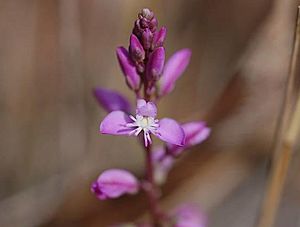Lewton's polygala facts for kids
Quick facts for kids Lewton's polygala |
|
|---|---|
 |
|
| Conservation status | |
| Scientific classification | |
| Genus: |
Polygala
|
| Species: |
lewtonii
|
Lewton's polygala, also called Lewton's milkwort (scientific name: Polygala lewtonii), is a very rare flowering plant. It belongs to the milkwort family. This special plant only grows in Florida, USA, mainly on the central ridge of the peninsula.
There are only about 49 places where this plant still grows. Many of these places have very few plants left. Lewton's polygala is in danger because its home is being lost or damaged. The United States government lists it as an endangered species, meaning it needs special protection to survive.
Contents
What Does Lewton's Polygala Look Like?
This plant is a short-lived perennial herb. This means it lives for more than two years but not forever, and it has soft stems instead of woody ones. It grows straight, fleshy stems up to 20 centimeters (about 8 inches) tall. These stems grow from the top of its main root, called a taproot.
The leaves on the plant are arranged one after another and overlap each other. Each larger leaf has several smaller leaves growing near its base. The leaves are shaped like a line or a small spoon and are about one centimeter (less than half an inch) long.
Flowers and Reproduction
At the top of each stem, you'll find a short cluster of flowers, called an inflorescence. Lewton's polygala is unique because it has three different kinds of flowers!
Aboveground Flowers
The most common flowers are found on the stems. These are about half a centimeter long. They have pink, wing-like parts called sepals. In the middle, there are three smaller, tufted pink petals. These flowers need insects like bee-flies, flower flies, and leaf-cutter bees to carry pollen from one flower to another. This helps the plant make seeds.
Hidden Flowers
The plant also has two other types of flowers that stay closed. These flowers self-pollinate, meaning they use their own pollen to make seeds.
- Some closed flowers grow at the base of the plant, near the leaves. These are not very common.
- Even more unusual, some closed flowers grow underground! These are on a stalk up to 40 centimeters (about 16 inches) long, just below the soil surface. They are white and also self-pollinate.
Having both aboveground open flowers and underground closed flowers is very rare. This special way of growing is called amphicarpy. Fewer than 100 plant species in the world do this! The different types of flowers might appear at different times of the year.
Seeds and Ants
After the flowers are pollinated, the plant produces a fruit that is a small capsule. Inside are cylindrical seeds, each about 0.3 centimeters long. These seeds have tiny hairs that attract ants. The ants then collect and carry the seeds away, helping the plant spread to new places. A common ant that helps is Pheidole morrissii.
Where Does Lewton's Polygala Live?
This plant grows in the sandhills of Central Florida. It also lives in areas where sandhills meet Florida scrub habitats. These places are often covered with longleaf pine trees and different kinds of oak trees, like turkey oak.
You might also find Lewton's polygala in areas that have been recently cleared, such as dry, open spots around power lines. The soil in these areas is usually yellow sand. Other rare plants, like Warea amplexifolia and Nolina brittoniana, also share this special habitat.
Why Is Fire Important for This Plant?
The natural home of Lewton's polygala needs fire to stay healthy. Regular fires help the plant by clearing away other plants that might compete for space and sunlight. Fire also removes dead leaves and lichens that build up on the ground.
Even though the plant itself might burn in a fire, many new seedlings sprout in large numbers afterward. In one case, a population grew by 800% after a big fire! Scientists think that smoke from fires might help the seeds in the soil start to grow. Fire also helps the plants live longer, start reproducing earlier, and grow more densely.
What Threats Does It Face?
One big threat to Lewton's polygala is when people try to stop fires. This is called fire suppression. Since fire is so important for the plant, its numbers go down if its habitat doesn't burn for a long time.
Another major threat is the complete loss of its habitat. People are building homes and turning the yellow-sand areas into citrus groves. This destruction breaks up the plant's home into smaller pieces, a problem called habitat fragmentation. The remaining small areas are sometimes used by off-road vehicles, which can also harm the plants.
How Is It Protected?
Luckily, many places where Lewton's polygala grows are now protected. To help the habitat stay healthy, land managers use prescribed burns. These are fires that are carefully planned and set on purpose. Prescribed burns help bring the habitat back to its natural state, which is good for Lewton's polygala and other plants and animals that live there.


